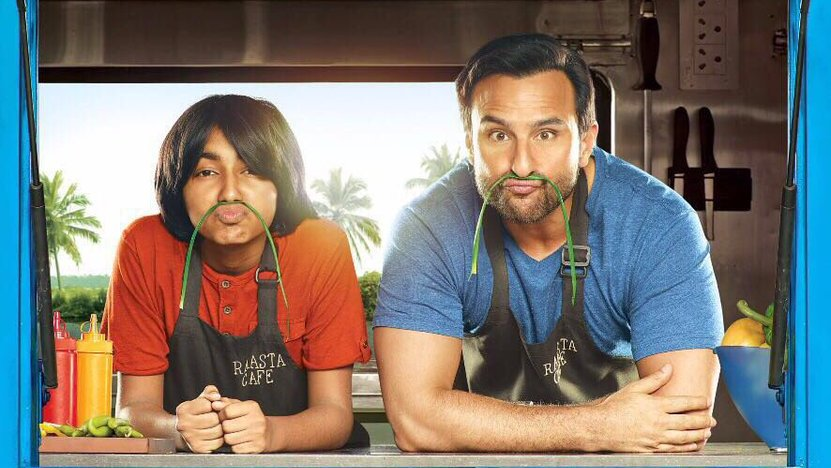The Superior Chef movie is The Bollywood Version
When you think of Bollywood movies, you probably think of this:

I wish this were the part of the article where I could say, "Aha! But you're wrong." But in fact, Bollywood is one of those industries where many of the commonly understood stereotypes tend to be true. Spontaneous bursting into song? Check. Colorful clothes? Check? Dramatic fights, and just a lot of drama in general? Check, check, check. I do want to clarify, though, that there does not actually exist a place called "Bollywood." I get asked this embarrassingly often.
These elements are the reason why I often tend to prefer Bollywood to Hollywood. That's especially true with Chef, the 2017 Bollywood remake of the 2014 Jon Favreau movie of the same name, about a disgraced chef who starts a food truck with his friend and son and finds redemption.
Why? In short, the food, the food, the food. In Hollywood, food content in a movie is usually an afterthought: a plate of pasta someone is mindlessly eating while on a date. Food-centric movies will feature very purposeful, highly stylized shots. The original Chef features all of the stereotypical "food porn": a sticky, charred slab of ribs from Franklin Barbecue in Austin; a very gooey grilled cheese sandwich made for the main character's son; and a perfectly composed plate of garlic chili spaghetti topped with a flurry of parmesan cheese that Scarlett Johanssen's character sensually laps up (I groaned a little bit at this part).
In India, and in Bollywood, food isn't stylized or tokenized. It's just an everyday part of life. In Bollywood movies, you'll often see people walking down the street sipping chai from a stainless steel cup; having meetings over bread pakoras; going to a wedding and eating fluffy kulchas and tomato and tamarind-flecked rassam. The food all looks delicious without any styling or direct camera shots to intentionally draw your eye.
In the Bollywood Chef, these are the moments that make the movie great. The food is a meaningful part of the narrative—every dish that Roshan (in the Jon Favreau role played by Indian megastar Saif Ali Khan) consumes shows something unique about his character's evolution. When he's living in New York with his then-wife, he's making pasta and drinking wine, an attempt to fit into a city where he feels like a stranger. When he's showing his son, Arman, around his hometown of Chandni Chowk, he returns to his favorite chhole bhatture stand from childhood to eat perfectly puffy, stretchy, oil-soaked bhatture (the most classic of Chandni Chowk foods). Then Arman does the same, showing his father his favorite place in his hometown of Kochi to eat stringy idiyappams that get fried in sizzling oil, then soaked in egg curry. Later, Roshan goes behind the kitchen at one of his favorite restaurants to make roasted tomato chutney over an open flame that makes you want to reach out and dip your finger into the bowl on the screen. This is what food porn translates to in India—dishes that are comforting, familial, and tell a story.
This food in Chef is not precious or particularly visually stunning or stylized, but because it is so seamlessly woven into the protagonist's journey, it becomes even more tempting and interesting. Don't get me wrong—I love a rack of ribs as much as the next person—but the added context, and the lack of pretense make for a much more interesting, layered film.

It's not just the food in a vacuum that carries the film—it's all of the other things that surround the food, and help to bring it to life. For example, the drama: In the Bollywood Chef, we bear witness to an extended montage (in the form of a depressing song called "Tere Mere") showing Roshan and his ex-wife Radha's blissful first years of marriage, when Roshan would lovingly prepare the aforementioned pasta for her, and they would sit down over a bottle of wine to dinner every night. Gradually, Roshan gets busier—he's always on his phone during dinner! How rude! Radha gets resentful. Roshan won't give her the time of day even when she's pregnant. So she leaves. The montage is super-cheesy, yes, but it offers context we don't get in the original movie, and framing the action around the act of mealtime ends up being a particularly powerful mode of storytelling.
And then there's the singing and dancing characteristic of Bollywood. Nothing makes me want a rotza—the roti-panini hybrid that Roshan and his crew dream up as their food truck's star offering—more than the song "Shugal Laga Le," performed when Roshan reunites with old friends and feeds them spicy chicken-stuffed rotzas and plantain chips while they serenade the crowd with catchy guitar ditties. This scene possesses an unpretentious, communal feel: The way the characters dump their spread on a picnic table and devour it over beers, without a care in the world—like they could be any of your friends. There's a reason that people go to Bollywood movies for the songs alone—they are always bright spots in the movie, lifting it up and adding texture to pivotal plot points.
Bollywood movies, after all, are a lot like Disney movies—the plot is simple, the music is heightened, and the ending is happy. The good guys stand tall in the end; the bad guys get their comeuppance. What's not so artificial, though, is the food. Food is its own character in a movie like Chef—it tears apart (and then reunites) families; it rebuilds careers; it calls people home. It may not be as manicured as a sauce-slathered rib, or a dainty bowl of spaghetti, but that's because it has a much bigger, more important role to play. And the movie is better for it.
